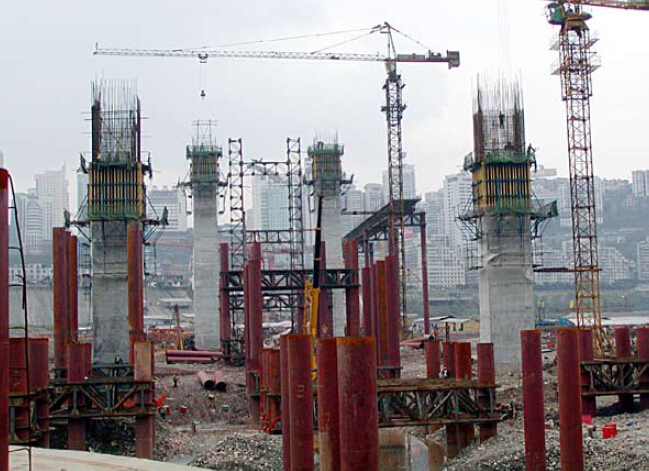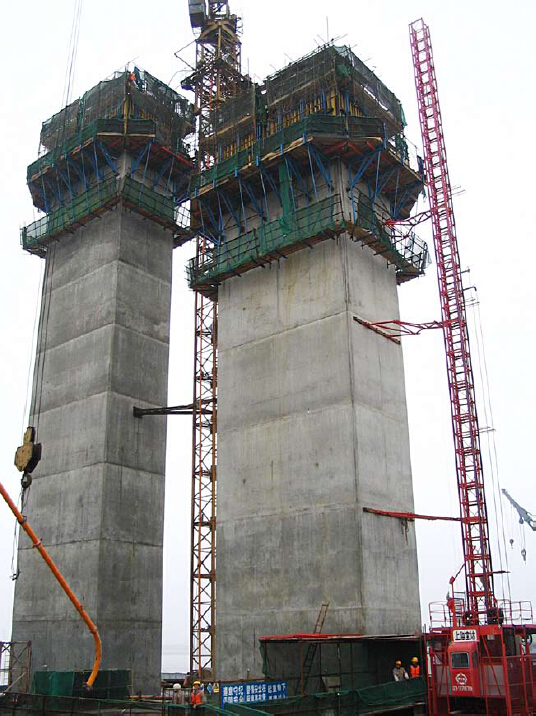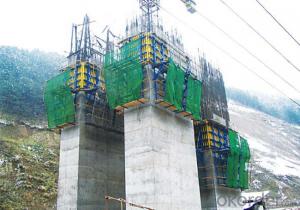Climbing Bracket CB-240 for formwork and scaffolding systems
- Loading Port:
- Tianjin
- Payment Terms:
- TT OR LC
- Min Order Qty:
- 50 m²
- Supply Capability:
- 1000 m²/month
OKorder Service Pledge
OKorder Financial Service
You Might Also Like
Climbing Bracket CB240 & CB210
They are framework brackets for supporting large-area wall formwork.
Typical applications for the CB240&CB210 are pier and column/shear wall/core walll/ in the
building.
CB210 has smaller size than CB240, it will be cost effective in some condition.
Characteristics:
◆ High bearing capacity
The high loading capacity of the brackets allow very large scaffold units. This saves the number
anchor points required as well as reducing climbing times.
◆ Simple moving procedure by crane
Through the strong connection of formwork together with the climbing scaffold, both can be moved
as a single climbing unit by crane. Thus valuable time-savings can be achieved.
◆ Fast striking process without a crane
With the retrusive set, large formwork elements can also be retracted quickly and a minimum of
effort.
◆ Safe with work platform
The platforms have assembled firmly with bracket and will be climbing together, without scaffolding
but can work safely in spite of your high location.


- Q:Can steel formwork be used for curved or irregular structures?
- Indeed, curved or irregular structures can be constructed using steel formwork. The utilization of steel formwork provides design flexibility and enables the easy shaping or fabrication of intricate geometries. Its strength and durability allow it to endure the immense pressure exerted during the pouring of concrete. With the ability to effortlessly adjust and adapt, steel formwork is well-suited for constructing structures with distinctive architectural designs or intricate layouts that incorporate curves, bends, or irregular shapes. Furthermore, the implementation of steel formwork guarantees a sleek finish to the concrete surface, resulting in structures of exceptional quality and aesthetic appeal.
- Q:How does steel formwork handle formwork alignment and leveling?
- The steel formwork system is a highly efficient and versatile solution that excels in the management of formwork alignment and leveling. It possesses numerous features and mechanisms that guarantee precise and accurate formwork placement. To begin with, the robustness and rigidity of steel formwork enable it to maintain its shape and dimensions throughout the pouring and curing of concrete. This inherent stability ensures that the formwork remains aligned and level during the entire construction process. Furthermore, steel formwork often incorporates adjustable components like screws, wedges, and clamps. These elements allow for fine-tuning of the formwork's position and elevation, facilitating precise alignment and leveling. By simply adjusting these components, workers can easily rectify any deviations and ensure perfect formwork alignment. Additionally, steel formwork systems frequently utilize integrated leveling systems. These systems typically consist of hydraulic jacks or mechanical devices that provide controlled and precise leveling. By utilizing these mechanisms, workers can effortlessly adjust the formwork's height and maintain a consistent level across the entire structure. Moreover, steel formwork possesses the ability to withstand significant loads and pressures exerted by the concrete during pouring. This strength enables it to resist any deformation or deflection, ensuring that the formwork remains aligned and level even under challenging conditions. In conclusion, the steel formwork system offers exceptional capabilities in managing formwork alignment and leveling. Its inherent stability, adjustable components, integrated leveling systems, and strength make it a reliable choice for maintaining the desired accuracy and precision during concrete construction projects.
- Q:What are the different types of release agents used with steel formwork?
- There are several types of release agents used with steel formwork, including petroleum-based agents, water-based agents, silicone-based agents, and wax-based agents. These release agents are applied to the surface of the formwork to prevent the concrete from sticking to it during the pouring and curing process. Each type of release agent has its own advantages and suitability for different applications, depending on factors such as the desired finish, ease of application, and environmental considerations.
- Q:Can steel formwork be used for precast concrete columns?
- Yes, steel formwork can be used for precast concrete columns. Steel formwork offers durability and strength, making it suitable for creating precise and complex shapes required for precast concrete columns. Additionally, steel formwork can be reused multiple times, making it a cost-effective option for precast concrete column production.
- Q:Can steel formwork be used for both manual and mechanical concrete pouring?
- Yes, steel formwork can be used for both manual and mechanical concrete pouring. Steel formwork is known for its durability and strength, making it suitable for handling the pressure and weight of concrete, whether it is poured manually or mechanically. It provides a stable and rigid structure that can withstand the forces exerted during pouring and curing of concrete. Additionally, steel formwork is versatile and can be easily adjusted or reassembled to accommodate different shapes and sizes of concrete structures. Hence, it is commonly used in construction projects where both manual and mechanical concrete pouring methods are employed.
- Q:How does steel formwork help in achieving accurate dimensions and shapes?
- Steel formwork helps in achieving accurate dimensions and shapes by providing a strong and rigid structure that holds the concrete in place during the curing process. This prevents any movement or deformation of the concrete, ensuring that it sets in the desired shape and size. The precise fabrication and assembly of steel formwork also allow for easy adjustment and customization, enabling accurate measurements and achieving the desired dimensions of the final structure.
- Q:How does steel formwork prevent concrete spillage?
- Steel formwork prevents concrete spillage by providing a strong and rigid structure that holds the wet concrete in place during the pouring and curing process. The steel panels create a tight enclosure around the concrete, preventing any leakage or spillage, ensuring that the concrete is properly contained within the desired shape and form.
- Q:What are the considerations when designing steel formwork for underground utilities?
- There are several essential factors to consider when designing steel formwork for underground utilities. These considerations encompass: 1. Structural Integrity: It is necessary to ensure that the formwork can withstand the pressure and forces exerted by the surrounding soil and any potential external loads. The design should offer sufficient strength and stability throughout the construction process. 2. Water and Chemical Resistance: Underground utilities are often exposed to water and various chemicals. Consequently, the formwork must be designed to resist corrosion and deterioration caused by these elements, ensuring its durability. 3. Accessibility for Installation and Maintenance: The formwork design should facilitate easy access during installation and future maintenance activities. This may involve incorporating provisions for openings, removable sections, or access points to allow workers to easily reach the utilities when necessary. 4. Modular Design: Utilizing a modular design can provide flexibility and simplify installation. Modular formwork systems enable quick assembly and disassembly, which proves advantageous when dealing with different underground utility layouts and configurations. 5. Safety: Safety is of utmost importance in any construction project. Therefore, the formwork design should include safety features such as guardrails, handrails, and anti-slip surfaces to minimize the risk of accidents and injuries during construction and maintenance. 6. Cost-effectiveness: The design should strike a balance between performance and cost. It should be optimized to minimize material usage and labor costs while maintaining quality and durability. 7. Compatibility with other construction methods: The design should be compatible with other construction methods and materials used for the underground utilities. This encompasses considerations for joining techniques, such as welding or bolting, and compatibility with other materials, such as concrete or PVC pipes. By taking these factors into account, designers can ensure that the steel formwork for underground utilities is structurally sound, resistant to environmental factors, easily accessible for installation and maintenance, safe for workers, cost-effective, and compatible with other construction methods.
- Q:Can steel formwork be used for precast concrete slabs with openings?
- Yes, steel formwork can be used for precast concrete slabs with openings. Steel formwork offers the flexibility and strength required to create openings in precast concrete slabs, ensuring precise and consistent results. Additionally, the durability and reusability of steel formwork make it a cost-effective choice for such applications.
- Q:Can steel formwork be used for architectural concrete slabs with embedded elements?
- Yes, steel formwork can be used for architectural concrete slabs with embedded elements. Steel formwork provides the necessary strength and durability to support the weight of the concrete and any embedded elements. It allows for precise shaping and detailing, ensuring the desired architectural design is achieved. Additionally, steel formwork can be easily re-used, making it a cost-effective option for such applications.
1. Manufacturer Overview |
|
|---|---|
| Location | |
| Year Established | |
| Annual Output Value | |
| Main Markets | |
| Company Certifications | |
2. Manufacturer Certificates |
|
|---|---|
| a) Certification Name | |
| Range | |
| Reference | |
| Validity Period | |
3. Manufacturer Capability |
|
|---|---|
| a)Trade Capacity | |
| Nearest Port | |
| Export Percentage | |
| No.of Employees in Trade Department | |
| Language Spoken: | |
| b)Factory Information | |
| Factory Size: | |
| No. of Production Lines | |
| Contract Manufacturing | |
| Product Price Range | |
Send your message to us
Climbing Bracket CB-240 for formwork and scaffolding systems
- Loading Port:
- Tianjin
- Payment Terms:
- TT OR LC
- Min Order Qty:
- 50 m²
- Supply Capability:
- 1000 m²/month
OKorder Service Pledge
OKorder Financial Service
Similar products
New products
Hot products























